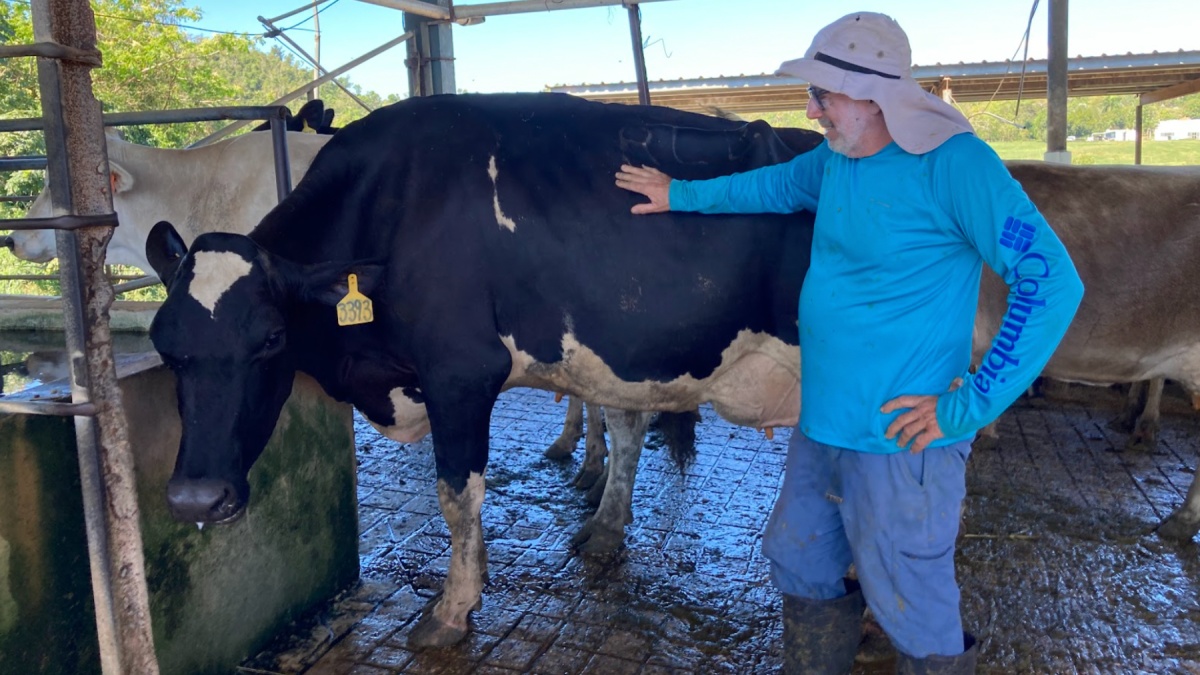
A natural mutation found in Puerto Rican dairy cows might keep them healthier in extreme heat.
This article originally appeared in Nexus Media News and Ambrook Research.
“In hot, humid conditions, the slick cows have an advantage,” López-López said on a scorching spring morning, walking among his herd in the shade of the milking barn. The genetic mutation that gives slick cows a shorter coat and more active sweat glands helps them maintain a healthy body temperature—an asset on a heating planet.

Cows are most comfortable in temperatures between 41 and 77 degrees Fahrenheit, which means livestock around the world are struggling to cope with hotter and longer summers. Over the span of just two hot, humid days in June 2022, an estimated 10,000 cows died in Kansas. Experts say it will only get worse.
“How do they produce more milk? They eat more, they metabolize more,” said Peter Hansen, a professor of animal sciences at the University of Florida who studies the slick mutation. “So any cow that’s producing more milk is going to be producing more body heat, which makes it harder to resist heat stress.”
When a dairy cow’s temperature rises above her normal core body temperature of 102.8 degrees Fahrenheit—which happens when the heat index is greater than 72—she experiences heat stress, meaning the ability to regulate her internal temperature is compromised. She grazes less (eating about 3% to 5% less per additional degree of ambient temperature) and has greater difficulty getting pregnant. That, in turn, compromises her milk supply. Heat stress also suppresses the immune system, leaving her more susceptible to disease.
Cows with the slick mutation, however, appear to be coping relatively well.
The slick mutation has been identified in at least six different cattle breeds around the world, including in Carora cows in Venezuela and Senepol cows on the Caribbean island of Saint Croix.
Dairy farmers are paying closest attention to the slick Holstein. Traditional Holsteins are the top milk-producing cow in terms of volume, but the temperate breed that originated in the Netherlands about 2,000 years ago isn’t well-adapted to heat and humidity. However, studies have shown that Holsteins with the slick mutation are able to keep their body temperature about 1 degree Fahrenheit cooler, meaning their milk production and fertility don’t drop as much as non-slick animals during the hottest months.
“I get 1,800 pounds [more] of milk per lactation from these cows, and they reproduce more effectively,” said López-López.
Still, breeding for the slick cows is widely seen as a promising strategy and is being used by farmers in places like South and Central America, Indonesia, Thailand, and Qatar. It was listed among adaptations to heat stress in livestock in the IPCC’s Sixth Assessment Report.
“Hot parts of the world are getting hotter, and parts of the world where heat stress was just an occasional problem are going to find that it’s a more severe problem,” said Hansen. “The more the climate is such that cows are exposed to a lot of heat stress, the more important the [slick] gene is going to be.”
The slick Holstein likely originated when Holsteins from the U.S. were brought to Puerto Rico in the 1950s to increase milk production on the island. (Puerto Rico produces about 200 million liters of milk each year, making it the island’s top agricultural commodity.) The Holsteins were crossed with Criollo cows, a breed raised for both beef and dairy that’s become heat-tolerant in the centuries since the Spanish colonists introduced them to the island. Scientists suspect that these cows already had the slick mutation and passed it on to the Holsteins.
Researchers also think slick cows may be better able to produce reproductive hormones because they’re not spending as much energy releasing heat from their bodies. Esbal Jiménez-Cabán, a professor of animal sciences at the University of Puerto Rico, pointed out that in both humans and animals, reproduction is among the first biological functions to be compromised in adverse conditions.
“If a guy is stressed, his sperm count goes down. If women don’t eat well, the menstrual cycle goes crazy,” he said. “A wild-type animal, when it’s fighting the heat in the summer, it will prioritize staying alive.”
In the mainland U.S., only a small number of farmers, mostly in the South, currently breed the slick gene into their herds—but that’s starting to change. In 2019, López-López sold his bull Sinba to a heat tolerance-focused breeder in Texas; from there, more U.S. breeders bought up Sinba’s semen to start breeding their own slick cows.
Jeffrey Bewley, a breeder in Kentucky, began selling slick embryos soon thereafter.
“Despite all our efforts to try to cool the cow, there’s still effective heat stress,” Bewley said, noting that cows experience heat stress about 150 days of the year in Kentucky.
“What really resonated with me was the idea that we might be able to breed for an animal that’s better able to handle the heat instead of just changing their environment,” he said.

























